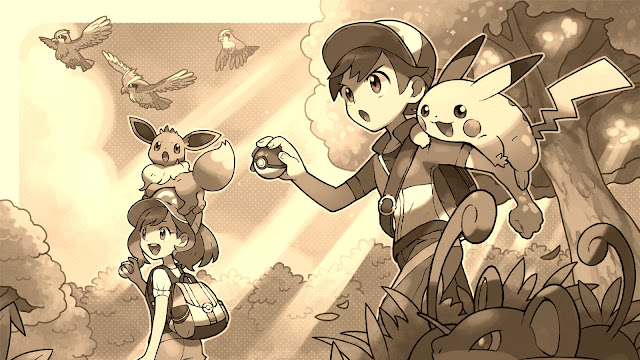Pokémon Let's Go - Fauna in patterns
I have already published my opinion on Pokémon, and everything said there, good and bad, especially regarding the seventh generation, applies broadly to Pokémon Let's Go. However, the game differentiates itself from previous entries due to the capture system. Pokémon Let's Go abandons random combats and instead makes its wild creatures visible on the field, while removing combat in favor of allowing the player to face the creature and capture it directly. To give complexity to this mechanic, the game takes the capture system from Pokémon Go, where a precise throw becomes decisive. Moreover, the more precise is the throw, or better streak you have, the more experience you get, which is the game's incentive to master this system. Beyond trying to catch the attention of players that entered the series through Pokémon Go, the developers offer a different perspective to the essence of the franchise: To simulate the search and capture of creatures.
 |
| Pokémon Let's Go introduces new capture mechanics Pictured: Catching a Growlithe |
The game fails because its creatures aren't believable, and thus how we approach them isn't believable, either. When the monsters appear, they either stay still or move in patterns, waiting for the player to capture them without trying to attack you or flee, and then making a predictable animation to disrupt a throw or as a sign that they're escaping. This mechanization makes clear to the player that they're facing an artificial body, and the illusion of being in front of a living creature doesn't exist. We merely act according to preset patterns at our mercy whenever we want to catch them. Faking resistence without really challenging us. After all, it's just a game for kids, and director Junichi Masuda believes that more is too much for them.
 |
| The Last Guardian, for PlayStation 4 Pictured: Trico |
This reduction of animal behavior to patterns is especially unacceptable after The Last Guardian became a milestone in the representation of a living being. On that game there's an inmense graphic detail in Trico, and the animal doesn't obey frequently to simulate the difficulties in comunication due to the absence of language, all in name of the creature being believable to our senses so that we don't perceive it as an extension of our will, but rather as a different body with its own presence. Those who have had a pet know that sentiment. As many orders as we give, it's difficult that our pet does what we want, because it's a living being with its own will, separate from ours.
 |
| Pokémon Snap, for the Nintendo 64 Pictured: Gyarados appearing from a waterfall |
It's admittedly an unfair comparison because The Last Guardian took ten years of development, and has only one creature instead of 151, but then we can observe another game with a similar intent: Pokémon Snap. In that game we control a photographer whose goal is to have the best photographs in the creatures' natural habitat. The game fails to convey the feeling of an habitat because the progress is preset on rails, and some Pokémon also follow the pitfall of having patterns. However, every creature acts different according to its species, and even some of them have different attitudes within the same species. Besides, many creatures are hidden behind coherent requirements to their species, and they reveal themselves due to our interaction with the environment. We throw bait to bring them closer, stink bombs to make them go away, or play the Poké Flute to wake them up. One of the most memorable examples is taking a Magikarp to a waterfall, because according to the Pokédex, Magikarps evolve into Gyarados when they climb one, and that's what happens in the game. Because of the active involvement with the scenario and its creatures, the game manages to convince the player that it isn't a fauna willing to serve you. In fact they ignore you, and if they went their own way and you didn't pay attention, bad luck.
The examples that I mentioned aren't an ideal of what Pokémon Let's Go should be, but they're a demonstration that even if its premise is interesting within the context of the series, the execution is the laziest possible. If it's genuinely because of being a children's game, I consider such condescendence insulting to the coming generation when it's precisely them for whom we should give our best.




Comments
Post a Comment